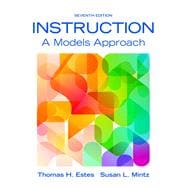Note: This is the loose-leaf version of Instruction and does not include access to the Enhanced Pearson eText. To order the Enhanced Pearson eText packaged with the loose-leaf version, use ISBN 0134046889.
Pre-service, beginning, and experience teachers alike can turn to this comprehensive resource for help in expanding their instructional repertoires through instructional models presented within a standards-based and instructionally aligned process. The authors present 10 evidence-based instructional models and their variations offering a range of cognitive approaches to instruction–creative, compliant, collaborative, competitive, inductive, deductive, concrete, and abstract. Each model is discussed using helpful elementary and secondary examples, a variety of academic content areas, detailed steps for implementation, and a look at the demands on students. The new edition of Instruction: A Models Approach includes several features that support the development of instructional skills: chapters move from concrete models to abstract (simple to more complex) to build a clearer understanding of the ideas, video examples and instructional strategies illustrate the concepts, and extension activities offer practice with important new information and skills. The result is a classroom-ready resource that makes instructional models clear and relevant for readers within a standards-based and instructionally aligned process. The Enhanced Pearson eText features embedded video and internet resources.
Improve mastery and retention with the Enhanced Pearson eText*
The Enhanced Pearson eText provides a rich, interactive learning environment designed to improve student mastery of content. The Enhanced Pearson eText is:
- Engaging. The new interactive, multimedia learning features were developed by the authors and other subject-matter experts to deepen and enrich the learning experience.
- Convenient. Enjoy instant online access from your computer or download the Pearson eText App to read on or offline on your iPad® and Android® tablet.*
- Affordable. Experience the advantages of the Enhanced Pearson eText along with all the benefits of print for 40% to 50% less than a print bound book.
* The Enhanced eText features are only available in the Pearson eText format. They are not available in third-party eTexts or downloads.
*The Pearson eText App is available on Google Play and in the App Store. It requires Android OS 3.1-4, a 7” or 10” tablet, or iPad iOS 5.0 or later.










